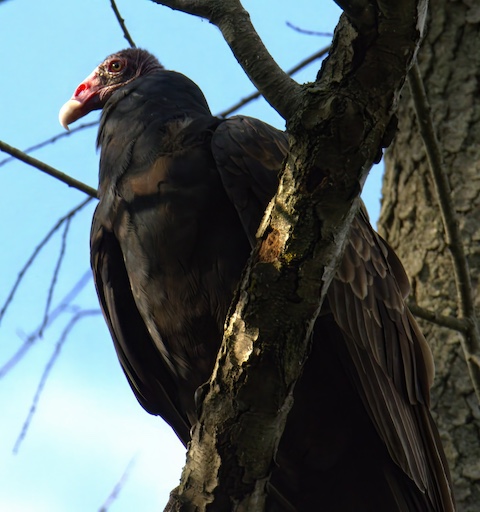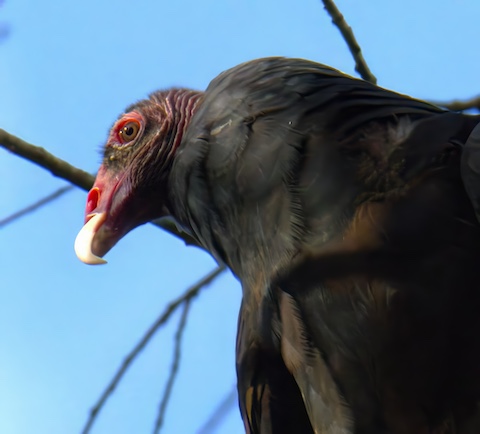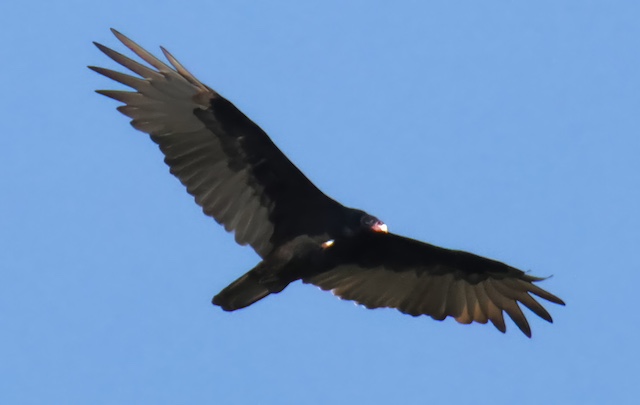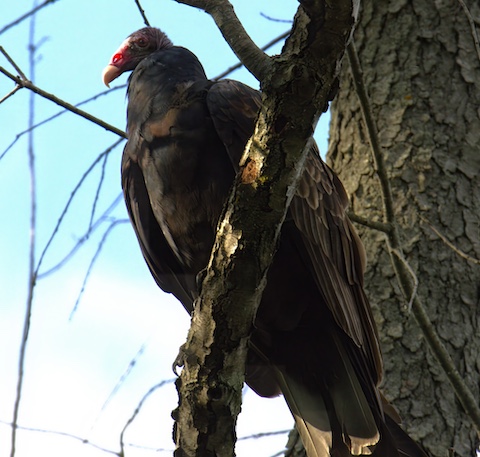… or A Face Only a Mother Could Love
This month’s Reflections on the Fox topic literally kind of flew into my mind one day a couple of weeks ago when I visited the Fox River observation platform at the Hoover Forest Preserve in Yorkville. This spot is one of my favorites for viewing all kinds of birds that live in our beautiful Fox River watershed, using the river for food, shelter, and a route of transportation. On this day, when I arrived, a large group of people was on the platform. I walked on, opting to check out another spot down the trail until the large party left. They were having fun and making a lot of noise, which was good for them, but not so good for attracting and seeing wildlife.
After about 20 minutes, I noticed that it had gotten noticeably quieter back near the platform, so I headed back. I saw the group retreating up the trail back toward the parking lot. I also noticed a large shadow moving over the canopy of the trees near the platform heading toward the river. I thought that a Bald Eagle must be heading back over the river and expectantly looked through a clearing in the trees to see if I could see it soaring over the river. There was no eagle though. As I turned up the short path from the main trail to the observation platform, I saw what had made the shadow: a Turkey Vulture was perched in the dead black walnut tree immediately adjacent to the platform!

In my experience, it’s very unusual to see a Turkey Vulture in such close proximity to people. I began taking photo after photo of the bird to take advantage of this rare opportunity. While I commonly see the vultures soaring over the river taking advantage of the afternoon thermals, searching out their next meal, their wings held in a dihedral (upturned at the tips) pattern and gliding along with a choppy rocking motion, I had never seen one perched in a tree so close to me before. I wondered if he or she had been attracted to the platform by the sounds of the people who had just left. I wondered if the bird thought that the people may have left something good to eat after their party. Whatever the reason for the vulture’s presence in the tree, I was very grateful that he/she was there!

you can really appreciate their size!
Turkey Vultures are a relatively common sight to see soaring over the Fix River during the months of the warm season here in the Fox Valley. They typically first appear in our area sometime in March and stay into early November. They have bright red, unfeathered heads, generally black plumage except for grayish-silver feathers on the trailing half of the underside of their wings, and a long, 6-plus foot wingspan. They have the most developed olfactory system of any bird and are said to be able to smell carrion from over a mile away. They are very efficient scavengers, eating dead animals and other carrion providing a great service to the environment.

The word “vulture” most likely comes from the Latin word vellere which means to pluck or tear. The Turkey Vulture plucks or tears at the carrion it eats with its sharp, hooked beak which is perfectly designed for that purpose. In a tribute to the environmental benefits the Turkey Vulture provides, its scientific name Cathartes aura translates roughly to golden purifier or purifying breeze according to Cornell Lab of Ornitthology “All About Birds” website.
I often see Turkey Vultures flying alone up and down the river, seldom flapping their large wings as they soar on the thermals, rocking back and forth with their wings held in a v-formation. Occasionally, I’ll see groups of 10-15 flying in circles over a certain area where they may have spotted food below. These circling groups of vultures are called kettles. Turkey Vultures are also known to roost for the evening in communal groups in dead trees or other high perches that provide them with a view of their surroundings and protection from any threats. While they are nearly as large as a Bald Eagle, these raptors pose no threat to any living smaller birds or animals as their feet are not strong and they have no talons to hunt with. They are peaceful scavengers.

on the rear half of the bottom of his wings.
Although there is a great contrast between their gracefulness in flight and their homely physical appearance, Turkey Vultures perform an important environmental service in our ecosystem. They act as nature’s waste managers, so to speak, cleaning up unsightly and unhealthy carrion. We are lucky to have these interesting birds in our watershed! Until next time, I hope you continue to enjoy the natural wonders the Fox River provides us. Keep on Fixin’ the Fox!


